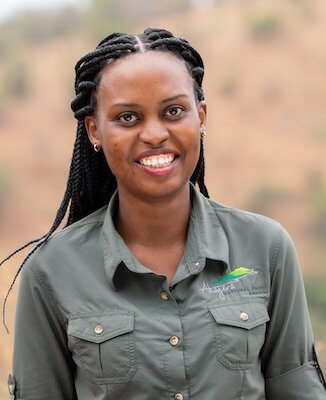Sensors already equip a range of tools to enhance monitoring capacity for conservation. Some of the higher bandwidth technologies, like camera traps and acoustic monitoring systems, have been essential elements of the conservation toolkit for decades, and thus have enough users that we've created dedicated WILDLABS groups to address them. But a whole range of lower bandwidth sensors beyond these core technologies are being increasingly integrated into conservation monitoring systems, and offer rich new insights into the wildlife and ecosystems we're all working to protect. As with many technologies, cost and access have historically been challenges to the adoption of new sensors, but with low-cost and open-source solutions on the rise, we're excited to see what the future of this space holds.
Getting Started with Sensors:
- Watch Shah Selbe's Tech Tutors episode on scaling FieldKit, an open-source conservation sensor toolbox, from a project to a successful conservation tech product.
- Check out our Virtual Meetup about Low-Cost, Open-Source Solutions in conservation tech, including a talk by Alasdair Davies on the Arribada Initiative's work with thermal sensors in early warning systems.
- For a more in-depth introduction, watch the first video in our datalogger mini-series: Freaklabs: How do I get started with Arduino?
In this group, you'll meet others who are using and innovating diverse sensors in their work, discuss ways to make sensors more effective & accessible for conservationists, learn about what sensors are already helping us accomplish in the field, and have the opportunity to ask and answer questions. Join this group to get started!
Header image: Emma Vogel, University of Tromsø
Ol Pejeta Conservancy
IT Engineer at The Conservation Tech Lab in Ol Pejeta Conservancy. |Endeavoring to implement tech solutions for conservation.



- 0 Resources
- 18 Discussions
- 10 Groups
Entrepreneur building AI-driven acoustic monitoring technology for comprehensive wildlife conservation, protection and ecosystem health monitoring.
- 0 Resources
- 0 Discussions
- 4 Groups
- @kimgavin
- | she/her
- 0 Resources
- 0 Discussions
- 9 Groups
- 1 Resources
- 1 Discussions
- 7 Groups
Queensland University of Technology (QUT)



- 1 Resources
- 18 Discussions
- 6 Groups
- @EllieW
- | She/Her



- 64 Resources
- 124 Discussions
- 14 Groups
- @ZestyResolution
- | He/Him
- 0 Resources
- 1 Discussions
- 6 Groups
- @LisaG
- | she/her/hers
- 0 Resources
- 1 Discussions
- 13 Groups
Sensing Clues Foundation



- 0 Resources
- 44 Discussions
- 9 Groups
MSc Engineering / IoT Engineer / Nature Enthusiast
- 0 Resources
- 0 Discussions
- 8 Groups
Senior Wildlife Research Scientist
- 0 Resources
- 0 Discussions
- 7 Groups
- 0 Resources
- 0 Discussions
- 3 Groups
In a recent publication we tested Underwater Passive Acoustic Monitoring (UPAM) as a feasible non-invasive technique to study the calling behavior of therathened aquatic Andean frogs under natural conditions in the...
6 April 2024
Article
You’re invited to the WILDLABS Variety Hour, a monthly event that connects you to conservation tech's most exciting projects, research, and ideas. We can't wait to bring you a whole new season of speakers and...
22 March 2024
This funding opportunity is to support projects to enhance existing, high TRL (7-9) marine biogeochemical sensors and integrate with National Marine Equipment Pool’s autonomous underwater platforms. You must be based...
11 March 2024
The IQOE Task Team on Low-Cost Hydrophones for Research, Education, and Citizen Science is looking for industry partners to develop a low-cost hydrophone.
15 December 2023
Funding
With $60,000, $30,000, and $10,000 grants available for 14 outstanding projects, the support of engineering and technology talent from Arm (the leading semiconductor design company), and access to the world’s biggest...
1 December 2023
Article
Read our interview with Clementine Uwamahoro, African Parks’ Country Manager in Conservation Technology overlooking technology operations for both Akagera National Park and Nyungwe National Park.
29 November 2023
The Department of Applied Ocean Physics and Engineering (AOPE) at the Woods Hole Oceanographic Institution (WHOI) seek to hire 1-2 scientists at any of the Assistant/Associate/Senior Scientist levels to develop research...
27 November 2023
TagRanger® is a state-of-the-art wildlife finding, monitoring and tracking solution for research, conservation and environmental professionals. With superior configurability for logging data, reporting location and...
23 November 2023
Yale University & Map of Life Rapid Assessments - XPRIZE
8 November 2023
Yale University & Map of Life Rapid Assessments - XPRIZE
8 November 2023
Yale University & Map of Life Rapid Assessments - XPRIZE
8 November 2023
The new white paper from Rainforest Connection (RFCx) explores the power of ecoacoustics and AI to monitor biodiversity and track progress towards GBF targets using case studies from around the world.
20 September 2023
April 2024
event
February 2023
January 2023
| Description | Activity | Replies | Groups | Updated |
|---|---|---|---|---|
| Hi everyone, @craig joined last month's Variety Hour to chat about Tagranger, which you can read more about here. A TagRanger®... |
|
Biologging, Connectivity, Sensors | 1 day 12 hours ago | |
| 'Most importantly, we have to make it play a MIDI version of the DoctorWho theme song when you arm the device. That has to be the #1 feature if you ask me!' Seconded! |
+9
|
Acoustics, Biologging, Emerging Tech, Open Source Solutions, Sensors | 2 days 13 hours ago | |
| Sounds good. Just sent you a private message. |
|
Climate Change, Conservation Tech Training and Education, Sensors | 4 days 10 hours ago | |
| This is so cool @Mauricio_Akmentins - congrats and look forward to seeing your project evolve! |
|
Acoustics, Biologging, Climate Change, Conservation Tech Training and Education, Data management and processing tools, Emerging Tech, Open Source Solutions, Protected Area Management Tools, Sensors, Software and Mobile Apps | 1 week 4 days ago | |
| First things first, our team, @jcguerra10, @hefca, and myself, is thrilled to share with immense pride... |
|
Build Your Own Data Logger Community, Data management and processing tools, Sensors | 2 weeks 4 days ago | |
| Hi @Henrikcox I hope you are well. I am not sure if you may remember myself and my colleague from CLS. We had a meeting and met in-person at Earthranger last year. ... |
+15
|
Human-Wildlife Conflict, Sensors | 3 weeks ago | |
| Unless you are planning on making a mesh network between nodes then the total distance spanning the location of all the nodes is important to know, not just the intra node... |
|
Sensors, Protected Area Management Tools | 1 month 2 weeks ago | |
| Hi Danilo. you seem very passionate about this initiative which is a good start.It is an interesting coincidence that I am starting another project for the coral reefs in the... |
|
Acoustics, AI for Conservation, Biologging, Camera Traps, Citizen Science, Climate Change, Community Base, Connectivity, Drones, Emerging Tech, Human-Wildlife Conflict, Open Source Solutions, Sensors, Software and Mobile Apps, Wildlife Crime | 2 months 2 weeks ago | |
| Real nice video. I'll have another look in the weekend in detail. |
+10
|
Acoustics, Community Base, Protected Area Management Tools, Remote Sensing & GIS, Sensors | 2 months 3 weeks ago | |
| Fire detection is a sort of broad idea. Usually people detect the products of fire, and most often this is smoke.Many home fire detectors in the US use a radioactive source... |
|
Community Base, Conservation Tech Training and Education, Data management and processing tools, Ethics of Conservation Tech, Human-Wildlife Conflict, Open Source Solutions, Protected Area Management Tools, Sensors, Wildlife Crime | 2 months 3 weeks ago | |
| Thank you for sharing! Super interesting, as we don't see many underwater stereo cameras! We also use Blue Robotics components in our projects and have found them reliable and... |
|
Sensors, Camera Traps, Marine Conservation | 3 months 3 weeks ago | |
| I am working on a prototype to detect and alert for temic & karbadust. They are used for the poisoning of waterholes in South Africa.... |
|
Sensors | 3 months 3 weeks ago |
Thermal imaging, drones, and sea turtles: a case study using FLIR’s new Duo Pro R camera
 Megan Ossmann
Megan Ossmann
23 August 2018 12:00am
How to share data on species to help conserve them… whilst avoiding them being exploited by poachers
 Ayesha Tulloch
Ayesha Tulloch
20 August 2018 12:00am
Ocean Hack: San Francisco, 10-11th September, 2018
 One Ocean Collab
One Ocean Collab
20 August 2018 12:00am
Thermal Sensor Project Update: Testing with live animals at the San Diego Zoo
 Arribada Initative
Arribada Initative
27 July 2018 12:00am
HWC Tech Challenge: Smart Electric Fence Solution
 Shadowview Foundation
Shadowview Foundation
5 June 2018 12:00am
From drone swarms to tree batteries, new tech is revolutionising ecology and conservation
 Euan Ritchie
Euan Ritchie
9 May 2018 12:00am
Eddy Expedition Log: Characterizing Eddies
23 April 2018 12:00am
HWC Tech Challenge: Thermopile Sensor Project
 Arribada Initative
Arribada Initative
19 April 2018 12:00am
Eddy Expedition Log: Chasing Eddies
 Elisha Wood-Charlson
Elisha Wood-Charlson
10 April 2018 12:00am
What technologies could help us monitor cave invertebrates?
23 July 2016 8:44am
9 April 2018 2:35am
Hi Tony, I'm leading a cross disciplinary group of researchers at Deakin University in Australia to build new technology for monitoring wildlife and engage citizen scientists with collecting data.
We have designed a video trap for monitoring reptiles and amphibians, that uses constant video and has some on-board AI to not save video with nothing in it. Works day and night (UV illumination at night), but uses a lot of power so we have a battery and solar panel arrangement. I expect this could be easily adapted to monitor cave fauna. Let me know if you already have a solution or want to discuss idea further.
Don Driscoll
Thermal imaging scopes
26 March 2018 9:26pm
27 March 2018 2:20pm
Hi Luke,
I'll leave specific recommendations to others who are better qualified ( @Eric+Becker @Rachel+Kramer or @Alasdair - maybe you can advise?) but I did come across something yesterday that may be relevant.
There is a live GroupGets campaign on at the moment (2 days left) for DIY-theromocam kits - not a scope but could do the trick if your budget is restricted as it's under $300 and you're willing to dabble in DIY?
The DIY-Thermocam is a do-it-yourself infrared camera, based on the FLIR Lepton long-wave infrared sensor and the popular Teensy 3.6 ARM Cortex M4 MCU.
The aim of this project is to give private persons, educational institutes and companies access to a portable, affordable and customizable thermal imaging plattform.
There are various applications like finding heat leaks in the insulation of buildings, the analysis of electrical or mechanical components, the detection of persons / animals or even mounting it on a drone, together with the additional video out module.
Constructed as a self-assembly solution, the DIY-Thermocam allows you to take advantage of the versatile possibilities of thermal imaging and to save money at one go.
Everything, from software to hardware, is completely open-source. This allows everyone to modify or extend the functionalities of the device to their own needs.
GroupGets does now offer a complete self-assembly kit, so you don't have to worry about buying all the parts on your own.
A scientific paper is also available, giving an overview about the whole project and its capabilities.
Update: haraldg has written a nice set of tools for post-processing the thermal raw data files. Check it out here. He also published a short article about manual calibration here.
3 April 2018 3:39pm
Hi @Luke_edwards - I just had a chat with my colleagues @Eric+Becker and @ColbyLoucks at WWF who will get back to you with some recommendations from experience with the thermal scopes that we've explored for anti-poaching (FLIR TK and SCOUT III).
Great to see that you're pairing conservation dogs and thermal imaging for wildlife surveys in Australia. In order to select the most cost-effective thermal imaging scope for your needs, it's important to know the range that you require, density of vegetation and size of the species you are monitoring. Can you share a bit more information on your parameters?
3 April 2018 11:03pm
The current project is in open plains. From a handler perspective the distance will be from 20m -100m. I will be working at night so it will be looking for me target, the Plains Wanderer, a small bird. Also it would be used to see other native and domestic animals in the area.
Other projects range from open plains through to rain forests.
The Plant-Powered Camera Trap Challenge
 Alasdair Davies
Alasdair Davies
3 April 2018 12:00am
Eddy Expedition Log: Setting Off to Explore Eddies
 Elisha Wood-Charlson
Elisha Wood-Charlson
3 April 2018 12:00am
Hacking together DIY time-lapse soil cameras
29 March 2018 11:35am
#Tech4Wildlife Photo Challenge 2018: Our Top 10
3 March 2018 12:00am
Landsense Innovation Challenge
19 February 2018 12:00am
Technology Empowered Conservation Lecture Series
 Paul Jepson
Paul Jepson
18 January 2018 12:00am
Instant Detect 2.0: A Connected Future for Conservation
 Sam Seccombe
Sam Seccombe
17 January 2018 12:00am
Congratulations to Zoohackathon winners, team ODINN!
 Zoological Society of London
Zoological Society of London
6 December 2017 12:00am
FIT Cheetahs
 Larissa Slaney
Larissa Slaney
4 December 2017 12:00am
How The San Diego Zoo Is Using AI And Drones To Save Polar Bears
 Mark Wallace
Mark Wallace
30 November 2017 12:00am
RaspberryPI
5 March 2016 7:35am
20 May 2016 11:10pm
Pi Zero get a little upgrade... Anyone need a camera trap?
http://petapixel.com/2016/05/19/5-raspberry-pi-zero-now-camera-compatible/

11 October 2017 10:09am
Hi All,
just sharing this for all those Raspberry Pi beginners like me, 91% off a training bundle
https://deals.thenextweb.com/sales/complete-raspberry-pi-3-2
2 November 2017 6:02pm
Also if you are still looking for a solution this was published earlier this year and gives recommendations for soundscape microphones : http://onlinelibrary.wiley.com/doi/10.1111/2041-210X.12678/full
HWC Tech Challenge Winners Announced
1 November 2017 12:00am
HWC Tech Challenge Update: Meet the Judges
20 October 2017 12:00am
Download New Conservation Tech Guidelines: Camera Traps, Acoustics and LiDAR
 Paul Glover-Kapfer
Paul Glover-Kapfer
11 October 2017 12:00am
Kids, Drones & Science At The Water’s Edge
 Cara Byington
Cara Byington
4 October 2017 12:00am
Saliva-powered paper battery
26 September 2017 2:55pm
How to lose a BRUV in 10 days
 Ivy Baremore
Ivy Baremore
26 September 2017 12:00am
DAS: A Scaleable Solution For Protected Area Management
 Camellia Williams
Camellia Williams
26 September 2017 12:00am
Elephant's Banquet
 Femke Hilderink
Femke Hilderink
19 September 2017 12:00am












































31 March 2023 2:15pm